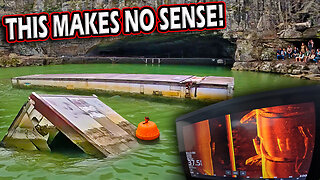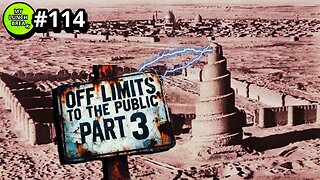Premium Only Content

Bob lazar Hydrogen Fuelled Corvette - Hydrogen Conversion Engine
Bob Lazar has logged at least 60,000 miles testing his hydrogen kit system, which is designed to convert fuel-injected gasoline-engine vehicles to run on hydrogen, while seamlessly allowing the vehicle to still run on gasoline when the hydrogen runs out.
The system he made and installed included a solar or wind-powered hydrogen production, stored in a hydride, and released when heated. It takes about 2-3 days to produce enough hydrogen to fill 4 hydride tanks, which gives a range of about 450 miles.
You can produce your own Hydrogen from electricity using either common "household current" or directly from solar cells so your energy cost is zero. It does however take a substantial amount of time to produce sufficient Hydrogen to fill even a small tank.
As an example, it takes over 2 days of our generator running at full power, 24 hours a day, to fill our smallest "short range" tank.
Storage
There are but 4 ways to do this:
1. Store the Hydrogen as a compressed gas.
2. Store the Hydrogen as a liquid.
3. Store the Hydrogen chemically bonded to a chemical.
4 Make it on demand as a gas and remove electrons or keep gas positive charged
5 Make it on demand and have is stored in water as a nano bubble suspension.
We'll cover each option in order.
1.Compressed Gas
If you choose to store the Hydrogen as a compressed gas, you'll need ,multiple or larger tanks, or higher storage pressures. The Standard is 300 to 600 Bar depending on application.
2. Choosing liquid
does solve the density problem since liquids are far more dense than gasses, so you can reduce the amount of tanks and their sizes required to power the car.
The liquid Hydrogen is cryogenic in short very cold.
It requires vacuum-thermos ( dewar ) tanks and vents to exhaust the boiling Hydrogen gas.
You'll also have to find a source for liquid Hydrogen which is far more expensive than Gasoline due to compression.
3. There are materials call Hydrides
that absorb Hydrogen like a sponge absorbs water. Typically, the tanks are filled with granulated Hydrides, and Hydrogen is pressurized into the material. Hydrides have many advantages over liquid & gas. One is that the density of the Hydrogen stored in the Hydride can be GREATER than that of liquid Hydrogen. This translates directly into smaller and fewer storage tanks.
Once the Hydride is "charged" with Hydrogen, the Hydrogen becomes chemically bonded to the chemical. Even opening the tank, or cutting it in half will not release the Hydrogen gas. In addition, you could even fire incendiary bullets through the tank and the Hydride would only smolder like a cigarette. It is in fact, a safer storage system than your Gasoline tank is.
Then how do you get the Hydrogen back out? To release the Hydrogen gas from the Hydride, it simply needs to be heated. This is either done electrically, using the waste exhaust heat, or using the waste radiator coolant heat.
The Corvette above heated the Hydride tanks electrically, and as soon at the Hydride is sufficiently warm, Hydrogen is released from the tanks and the on-board computer detects the presence of Hydrogen pressure. The fuel system remains in "Hydrogen" mode until the tank pressure begins to drop. If the tanks run out of Hydrogen, the engine will seamlessly switch over to Gasoline, which enables the car to run conventionally until the Hydrogen tanks are refilled.
4. It is possible to make a GTNT gas
a gas that is a positive charge missing electrons,(avoids and prevent water reforming until combusted ) in this case the engine is positive earthed to act as a electron sink. And or you can remove electrons and avoid ground back by reducing negative surfaces and ambient air contract. In that case all incoming air is gated with a diaphragm control intake and restricted air flow in and processed to be positive charged before rising with positive charged fuels. On demand as a gas and remove electrons or keep gas positive charged this ways instead of implosion you get explosive force with out heat. 2 x hho we cut the power of this fuel with positive charged EGR gas.
5.Water Fuel Suspensions
Make it on demand and have is stored in water as a nano bubble suspension.
This method is cutting edge and possibly the final solution to the world problems we use out knowledge in all of the above to control the charge temperature of water to hold dissolved h2 gas , so instead of 2 to1 h2 to 02 we have 10 to 1 or any mix we like until saturated.
Using Hydrogen, the only exhaust products produced are water vapor and a tiny amount of Nitrogen Oxides.
Which can be processed in a egr gas processor to ensure break up of nitrogen and the positive charge.
It's about as clean burning as you can get.
-
 2:33:15
2:33:15
Tundra Tactical
8 hours ago $9.36 earnedLuis Valdes Of GOA Joins The Worlds Okayest Firearms Live Stream!!!
30.7K -
 1:03:41
1:03:41
Man in America
16 hours agoAre Trump & Musk the COUNTER-ELITES? w/ Derrick Broze
76.5K39 -
 3:45:08
3:45:08
DLDAfterDark
7 hours ago $9.75 earnedDLD Live! SHTF Handguns! Which Would You Choose?
41.9K2 -
 1:50:38
1:50:38
Mally_Mouse
10 hours agoSaturday Shenanigans!! - Let's Play: Mario Party Jamboree
52.2K -
 1:13:00
1:13:00
Patriots With Grit
14 hours agoWill Americans Rise Up? | Jeff Calhoun
43.1K13 -
 14:55
14:55
Exploring With Nug
14 hours ago $11.27 earnedWe Found Semi Truck Containers While Searching for Missing Man!
59.4K7 -
 27:57
27:57
MYLUNCHBREAK CHANNEL PAGE
22 hours agoOff Limits to the Public - Pt 3
133K65 -
 38:07
38:07
Michael Franzese
14 hours agoLeaving Organized Crime and Uncovering Mob in Politics: Tudor Dixon and Michael Franzese
106K15 -
 2:42:54
2:42:54
Jewels Jones Live ®
2 days agoAMERICA IS BACK | A Political Rendezvous - Ep. 111
83.6K50 -
 8:47:33
8:47:33
Due Dissidence
1 day agoLIVE: Workers Strike Back Conference ft. Chris Hedges, Jill Stein, Kshama Sawant, and More!
120K92